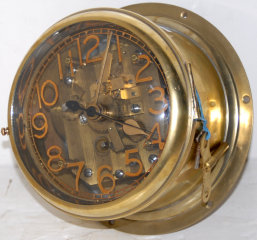
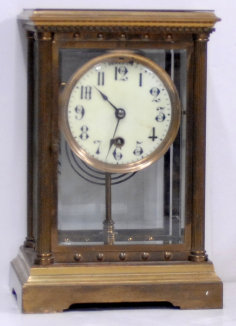
172. $450
Automatic Harp by “The Ward-Stilson Co. New London, Ohio”. There
are six strings on a stained wood case with tri-chromate transfer decoration. This is their model #9582. They made other harps with
different string arrangements. The on/off music box lever is near the base of the harp and it is playing one song. Underneath the
base is a paper label stating the name of the tune being played. The label inside is complete as are other parts of the music box
and case, except there are two missing guitar type strings. You can buy those strings at any music store. The music box in the bottom
of the case winds on the back of the case. This may be a well know company in middle America but their Harps were very rare. $500-$750.

173. $1200
“John Sawin, Boston”, signed on the original painted iron dial
of this Ca 1835-40 lyre timepiece. This early banjo is identical to the one pictured on page 135 in the book by Paul J. Foley, “Willard’s
Patent Time Pieces – A History of the Weight Driven Banjo Clock – 1800-1900”. The number “41” is written on the back of the throat
frame. The mahogany figured case with crotch veneer is about 39 ½ inches tall and it is doubtful the ornament on top of the case is
original and the lead weight is a later addition. All other parts appear to be original. The original signed dial is raised painted,
not ink. Original Sawin brass movement, wooden bezel with period 5 leaf hinges and spring door latch. Dial has 3 original triangular
slots with “L” shaped hold down screws/hooks. Original pendulum, old lead weight, original metal weight cover @ bottom with brass
hold down strip for pendulum. Weight cover behind the center glass has been removed, nails remain. A handwritten note on the back
of the door reads, “This clock made by John Sawin at one time apprenticed to Willard, afterwards his partner, was made to order for
Samuel Clarke at the time of his marriage to Sarah Houghton McKinley on Thanksgiving Day, 1840, at then “Old North Church”. I did
not hang the weight to test for running but turning the wheels by hand encountered no problems. Recent sales in the north-east are
running $4500 or more. $1500-$2000.
171. $275
Boston Clock Company, crystal regulator, aptly named, “Crystal”,
ca 1892. These unusual clocks have only one winding arbor and the key can be turned clockwise or counter clockwise to wind the
time spring or the strike spring. The hands can also be turned in either direction. This four-glass crystal regulator is just under
11 inches tall, has a fine gold plated case, some gold remaining but looks brass to me. Beveled glasses, front, back and sides. Front
glass has a small chip. If it bothers you exchange for the door on the back. The 8-day movement is running and striking the gong on
half hours and hours. The porcelain dial is very good and the hands are correct. Ehrhardt, Volume 1, pages 74-75, pictures Boston
Clock Company clocks and explains about their rare movements. $300-$400.
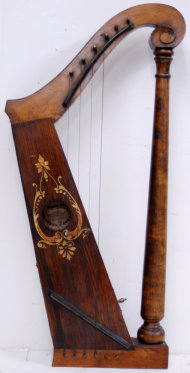
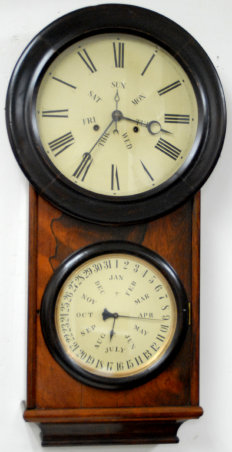
174. $850
“L. F. & W. W. Carter Calendar”, in a B. B. Lewis Calendar
No. 2 case, ca 1862. Brothers Luther and William made calendar clocks in Bristol, Conn. using the B.B. Lewis patent calendar mechanisms.
The beautiful rosewood case is 32 inches, has two wood bezels with old or original glasses. The 12-inch time dial and 8 inch calendar
dial are both professionally repainted. The B. B. Lewis perpetual calendar mechanism is behind the lower dial and covered with a metal
plate and a very nice green label bearing the makers name and address, and identifying him as “The Inventor”. The inside paper label
on the backboard has slight wear but is complete, identifying the maker and other pertinent information. The two iron weights, pendulum,
hands, both movements, and all case hardware, appear to be original to the clock. There is a lock on the bottom bezel, but no key.
The rosewood is attractively polished and ready for your enjoyment or resale. Both movements are functioning properly. This is one
of the nicer Carter calendar clocks we have ever offered. Ly-Calendar, page 41 and 171. $1000-$1500.
170. $350
Rare English fusee ships clock with dial painted on glass and
the 8-day movement visible behind the glass. Both the movement and case are numbered but no signature is visible. The heavy brass
bezel and bowed glass are held with a key lock on the side. The back flange is 9.5 inches and the case is 5 inches high. The three
hands appear to be original, the movement is running and the clock is complete. It has a locking key and a winding key. $400-$600.

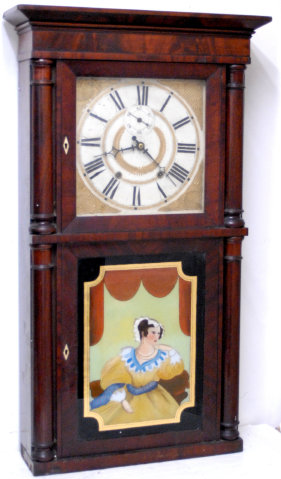
175. $300
Riley Whiting, 8-day wood movement double decker clock. A complete
label inside reads in part, “Modern Improved / Eight-day / CLOCKS / Made By / Riley Whiting / Winchester, Conn.” He made wood movement
shelf clocks from 1828-1835. This mahogany veneered case is 36 inches tall, has very nice veneer all over but undoubtedly you could
find some corner nicks if you look closely and the bottom board is a little scuffed on the sides. There are four turned columns on
this double decker case style and it has a cornice top. The top glass is held with what appears to be the original wood strips, and
the bottom glass being the correct style, may be a replacement painted by Tom Moberg, and is held with new or additional putty. There
are two ivory escutcheons and two door locks, but no key. The wood dial with gold paint remains in pretty nice original condition,
a little dirty but paint is good. Note it has a seconds dial and on the back are several penciled repair notes. The hands are of the
period, as are the pair of large iron weights. The 8-day wooden movement, dial with seconds bit, cords and compounded pulleys on cords,
hands, pendulum, pendulum rod and weights are all original or of the period. Reference: “Eight-day Wood Movement Shelf Clocks-Their
Cases, Their Movements, Their Makers”, by Bryan Rogers and Snowden Taylor. This case, movement, and glasses are pictured and discussed.
$300-$500.
